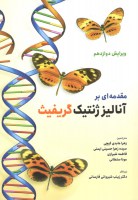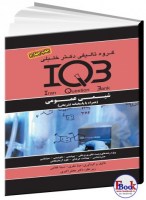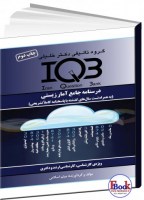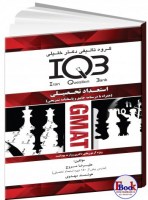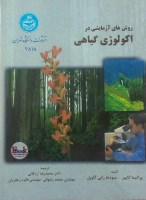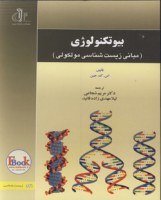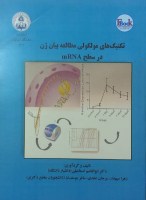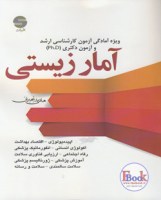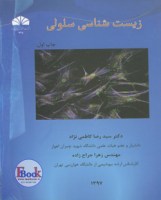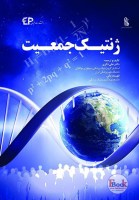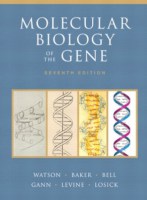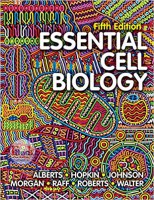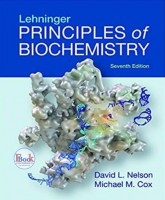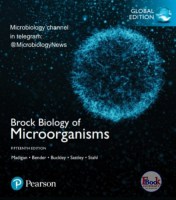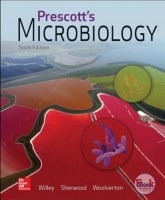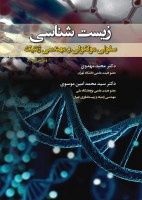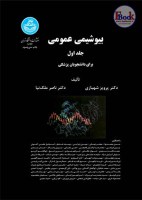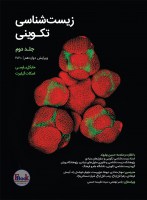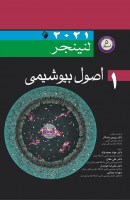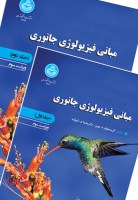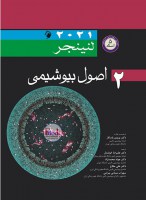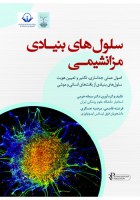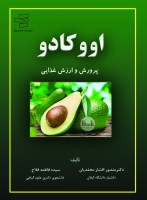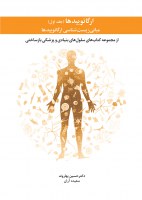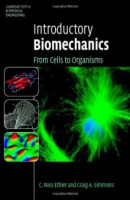دسته بندی
مقدمه ای بر آنالیز ژنتیک گریفتث (حیدری)
کتاب مقدمه ای بر آنالیز ژنتیک گریفیث زهرا عابدی کیچی، زهرا حسینی ایمنی ، فاطمه شیرازی، مونا سلطانی انتشارات حیدری
ترجمه ویرایش دوازدهم کتاب Introduction to Genetic Analysis (مقدمه ای بر آنالیز ژنتیک) به عنوان مرجع علمی و معتبر دانشگاهی در سطح بین الملل است که تمامی سرفصل های تدوین شده برای درس ژنتیک را پوشش میدهد. در این کتاب، اصول پایه علم ژنتیک در بیست فصل به زبانی ساده بیان شده است. در ابتدای هر فصل هدف فصل و در ادامه مفاهیم کلی به همراه مثال ها، آزمایشات و آخرین دستاوردهای علمی مطرح شده است و نهایتا تمرینات آخر فصل به منظور ارزیابی بهتر مطالب در سه سطح بیان گردیده است. از این رو کتاب مقدمه ای بر آنالیز ژنتیک می تواند به عنوان کتاب درسی برای دانشجویان ژنتیک مولکولی و انسانی، پزشکی، بیوتکنولوژی، کشاورزی و گرایش های مختلف زیست شناسی و هم چنین یکی از منابع آزمون المپیاد زیست شناسی معرفی گردد. تا حد توان سعی شده است که ترجمه ای روان با رعایت امانت ارائه شود.
شیمی آلی ولهارد جلد اول
فهرست مطالب:
1- ساختار و تشکیل پیوند در مولکولهای آلی
2- ساختار و فعالیت
اسیدها و بازها، مولکولهای قطبی و غیرقطبی
3- واکنشهای الکانها
انرژیهای تفکیک پیوند، هالوژناسیون رادیکالی، و فعالیت نسبی
4- سیکلوآلکانها
5- ایزومرهای فضایی
6- خواص و واکنشهای هالوالکان
واکنشهای استخلافی هستهدوستی (نوکلئوفیلی) دو مولکولی
7- واکنشهای بیشتری از هالوالکانها
واکنش استخلافی یک مولکولی و مسیرهای حذفی
8- گروه عاملی هیدروکسی
خواص الکلها و سنتزهای استراتژیک
9- واکنشهای بیشتری از الکلها و شیمی اترها
10- کاربرد طیفسنجی رزونانس مغناطیسی هستهای در تعیین ساختار مولکولی
شیمی آلی ولهارد جلد سوم
فهرست مطالب:
19- کربوکسیلیک اسیدها
20- مشتقات کربوکسیلیک اسید
21- آمینها و مشتقات آنها
گروههای عاملی حاوی نیتروژن
22- شیمی استخلافهای بنزن
آلکیل بنزنها، فنولها و بنزن آمینها
23- استر انولاتها و تراکم کلایزن
سنتز ترکیبات B – دیکربونیل؛
معادلهای آسیل آنیون
24- کربوهیدراتها
ترکیبات چندعاملی در طبیعت
25- هتروسیکلها
هترواتمها در ترکیبات آلی حلقوی
26- آمینواسیدها، پپتیدها، پروتئینها و نوکلئیک اسیدها
پلیمرهای حاوی نیتروژن در طبیعت
مقدمه ای بر فیزیولوژی گیاهی جلد اول (دانشگاه تهران)
موضوع مورد بحث این کتاب این است که گیاهان چگونه اعمال خود را انجام می دهند. این کتاب درباره
سوالاتی است که فیزیولوژیست های گیاهی مطرح می کنند و چگونه برای یافتن پاسخ به این سوالات به
جستجو می پردازند. کتاب مقدمه ای بر فیزیولوژی گیاهی عمدتاً درباره این موضوع است که گیاهان چگونه
چیزهایی را که هر روز در زندگی روزمره خود تجربه می کنند، انجام می دهند.
ژنتیک مولکولی واتسون 2014 زبان اصلی
About the Author
James D. Watson is Chancellor Emeritus at Cold Spring Harbor Laboratory, where he was previously its Director from 1968 to 1993, President from 1994 to 2003, and Chancellor from 2003 to 2007. He spent his undergraduate years at the University of Chicago and received his Ph.D. in 1950 from Indiana University. Between 1950 and 1953, he did postdoctoral research in Copenhagen and Cambridge, England. While at Cambridge, he began the collaboration that resulted in the elucidation of the double-helical structure of DNA in 1953. (For this discovery, Watson, Francis Crick, and Maurice Wilkins were awarded the Nobel Prize in 1962.) Later in 1953, he went to the California Institute of Technology. He moved to Harvard in 1955, where he taught and did research on RNA synthesis and protein synthesis until 1976. He was the first Director of the National Center for Genome Research of the National Institutes of Health from 1989 to 1992. Dr. Watson was sole author of the first, second, and third editions of Molecular Biology of the Gene, and a co-author of the fourth, fifth and sixth editions. These were published in 1965, 1970, 1976, 1987, 2003, and 2007, respectively. He is also a co-author of two other textbooks: Molecular Biology of the Cell and Recombinant DNA, as well as author of the celebrated 1968 memoir, The Double Helix, which in 2012 was listed by the Library Of Congress as one of the 88 books that shaped America.________________________________________
Tania A. Baker is the Head of the Department and Whitehead Professor of Biology at the Massachusetts Institute of Technology, and an Investigator of the Howard Hughes Medical Institute. She received a B.S. in biochemistry from the University of Wisconsin, Madison, and a Ph.D. in biochemistry from Stanford University in 1988. Her graduate research was carried out in the laboratory of Professor Arthur Kornberg and focused on mechanisms of initiation of DNA replication. She did postdoctoral research in the laboratory of Dr. Kiyoshi Mizuuchi at the National Institutes of Health, studying the mechanism and regulation of DNA transposition. Her current research explores mechanisms and regulation of genetic recombination, enzyme-catalyzed protein unfolding, and ATP-dependent protein degradation. Professor Baker received the 2001 Eli Lilly Research Award from the American Society of Microbiology and the 2000 MIT School of Science Teaching Prize for Undergraduate Education and is a fellow of the American Academy of Arts and Sciences since 2004 and was elected to the National Academy of Sciences in 2007. She is co-author (with Arthur Kornberg) of the book DNA Replication, Second Edition.
________________________________________
Stephen P. Bell is a Professor of Biology at the Massachusetts Institute of Technology and an Investigator of the Howard Hughes Medical Institute. He received B.A. degrees from the Department of Biochemistry, Molecular Biology, and Cell Biology and the Integrated Sciences Program at Northwestern University and a Ph.D. in biochemistry at the University of California, Berkeley in 1991. His graduate research was carried out in the laboratory of Dr. Robert Tjian and focused on eukaryotic transcription. He did postdoctoral research in the laboratory of Dr. Bruce Stillman at Cold Spring Harbor Laboratory, working on the initiation of eukaryotic DNA replication. His current research focuses on the mechanisms controlling the duplication of eukaryotic chromosomes. Professor Bell received the 2001 ASBMB–Schering Plough Scientific Achievement Award, the 1998 Everett Moore Baker Memorial Award for Excellence in Undergraduate Teaching at MIT and the 2006 MIT School of Science Teaching Award.
________________________________________
Alexander A.F. Gann is the Lita Annenberg Hazen Dean and Professor in the Watson School of Biological Sciences at Cold Spring Harbor Laboratory. He is also a Senior Editor at Cold Spring Harbor Laboratory Press. He received his B.Sc in microbiology from University College London and a Ph.D. in molecular biology from The University of Edinburgh in 1989. His graduate research was carried out in the laboratory of Noreen Murray and focused on DNA recognition by restriction enzymes. He did postdoctoral research in the laboratory of Mark Ptashne at Harvard, working on transcriptional regulation, and that of Jeremy Brockes at the Ludwig Institute of Cancer Research at University College London, where he worked on newt limb regeneration. He was a Lecturer at Lancaster University, U.K., from 1996 to 1999, before moving to Cold Spring Harbor Laboratory. He is co-author (with Mark Ptashne) of the book Genes & Signals (2002), and co-editor (with Jan Witkowski) of The Annotated & Illustrated Double Helix.
________________________________________
Michael Levine is a Professor of Genetics, Genomics and Development at the University of California, Berkeley, and is also Co-Director of the Center for Integrative Genomics. He received his B.A. from the Department of Genetics at University of California, Berkeley, and his Ph.D. with Alan Garen in the Department of Molecular Biophysics and Biochemistry from Yale University in 1981. As a postdoctoral fellow with Walter Gehring and Gerry Rubin from 1982-1984, he studied the molecular genetics of Drosophila development. Professor Levine's research group currently studies the gene networks responsible for the gastrulation of the Drosophila and Ciona (sea squirt) embryos. He holds the F. Williams Chair in Genetics and Development at University of California, Berkeley. He was awarded the Monsanto Prize in Molecular Biology from the National Academy of Sciences in 1996, and was elected to the American Academy of Arts and Sciences in 1996 and the National Academy of Sciences in 1998.
________________________________________
Richard M. Losick is the Maria Moors Cabot Professor of Biology, a Harvard College Professor, and a Howard Hughes Medical Institute Professor in the Faculty of Arts & Sciences at Harvard University. He received his A.B. in chemistry at Princeton University and his Ph.D. in biochemistry at the Massachusetts Institute of Technology. Upon completion of his graduate work, Professor Losick was named a Junior Fellow of the Harvard Society of Fellows when he began his studies on RNA polymerase and the regulation of gene transcription in bacteria. Professor Losick is a past Chairman of the Departments of Cellular and Developmental Biology and Molecular and Cellular Biology at Harvard University. He received the Camille and Henry Dreyfuss Teacher-Scholar Award, is a member of the National Academy of Sciences, a Fellow of the American Academy of Arts and Sciences, a Fellow of the American Association for the Advancement of Science, a Fellow of the American Academy of Microbiology, a member of the American Philosophical Society, and a former Visiting Scholar of the Phi Beta Kappa Society. Professor Losick is the 2007 winner of the Selman A. Waksman Award of the National Academy of Sciences, a 2009 winner of the Canada Gairdner Award, and a 2012 winner of the Louisa Gross Horwitz Prize for Biology or Biochemistry of Columbia University.
زیست شناسی سلولی مولکولی و مهندسی ژنتیک
کتاب زیست شناسی سلولی مولکولی و مهندسی ژنتیک اثر دکتر مجید مهدوی (عضو هیات علمی دانشگاه تهران) و دکتر سید محمد امین موسوی (عضو هیات علمی پژوهشگاه ملی مهندسی ژنتیک و زیست فن آوری تهران) تاکنون چندین بار تجدید چاپ شده و اکنون ویرایش چهارم این اثر کاربردی، در خانه زیست شناسی-انتشارات کنام به چاپ رسیده است.
تشریح کامل مسایل شیمی آلی ولهارد جلد سوم
فهرست مطالب:
19. کربوکسیلیک اسیدها
20. مشتقات کربوکسیلیک اسیدها
21. آمینها و مشتقات آنها: گروههای عاملی حاوی نیتروژن
22. شیمی استخلافهای بنزن: آلکیل بنزنها، فنولها و بنزنآمینها
23. استر انولاتها و تراکم کلایزن: سنتز ترکیبات بتا-دیکربونیل: معادل آنیون آسیل
24. کربوهیدراتها: ترکیبات چندعاملی در طبیعت
25. هتروسیلکلها: هترواتمها در ترکیبات آلی حلوقی
26. آمینو اسیدها، پپتیدها، پروتئینها و نوکلئیک اسیدها: پلیمرهای حاوی نیتروژن در طبیعت
اصول بیوشیمی لنینجر 2021 جلد اول (اندیشه رفیع)
کتاب اصول بيوشيمی لنينجر 2021 جلد اول ترجمه "دکتر پاسالار، دکتر محمدنژاد و همکاران، در سال 1400 توسط انتشارات اندیشه رفیع منتشر شده است.
در این کتاب پدیدههای مختلف بیولوژیک ازجمله ساختار شیمیایی اجزاء تشکیل دهند سلول، درک مکانیسم عمل آنزیم و واکنشهای بیوشیمیایی کاتالیز شده مورد بررسی قرار گرفته است. کتاب بیوشیمی لنینجر یکی از معتبر ترین منابع برای امتحانات ورودی مقطع کارشناسی ارشد و دکتری معرفی شده است. در ویرایش جدید این کتاب، مطالب جدیدی به مباحث بیولوژی مولکولی، ساختار پروتئین، پیام رسان زیستی و مهندسی ژنتیک اضافه شده است.
این کتاب مورد استفاده تمامی افراد فعال در رشته های بیوتکنولوژی پزشکی و کشاورزی،میکروب شناسی ایمنی شناسی، آسیب شناسی، ژنتیک، تغذیه، فارماکولوژی، داروسازی، مهندسی بافت و ... است. این کتاب 614 صفحه ای و تمام رنگی، شامل مباحث زیر است:
فصل 1_پایههای بیوشیمی
بخش 1_ساختار و کاتالیز
فصل 2_آب،مایع حیات
فصل 3_اسیدهای آمینه،پپتیدها و پروتئینها
فصل 4_ساختار سه بعدی پروتئینها
فصل 5_عملکرد پروتئین
فصل 6_آنزیمها
فصل 7_کربوهیدراتها و گلیکوبیولوژی
فصل 8_نوکئوتیدها و اسیدهای نوکلئیک
فصل 9_تکنولوژی های اطلاعات برپایه DNA
فصل 10_لیپیدها
فصل 11_غشاهای بیولوژیک و انتقال
فصل 12_پیامرسانی زیستی
مبانی فیزیولوژی جانوری مویز جلد اول و دوم
مبانی فیزیولوژی جانوری مویز جلد اول
مبانی فیزیولوژی جانوری مویز جلد دوم
ويراست سوم
تالیف : كريستوفر د. مويز , پاتريشيا م. شولت
ترجمه : آمنه رضايوف , آمنه زارع چاهوكي , زهرا شيرازي زند , سيد پيمان مقدسي
انتشارات دانشگاه تهران
چاپ اول- 1400
سلول های بنیادی مزانشیمی (رویان پژوه)
سلولهای بنیادی، سلولهایی بالغ با توانایی خودتجدید شوندگی و تمایز به ردههای سلولی مختلف میباشند.
بیش از دو دهه قبل، اولین بار سلولهای مزانشیمی از مغز استخوان جداسازی شدند و آزمایشات مختلف در شرایط آزمایشگاهی و در داخل بدن موجود زنده،
عملکردهای متنوع این سلولها را نشان داده است. سلولهای بنیادی مزانشیمی در تکامل و ترمیم سلولهای بنیادی موجود در زیر محیط مغز استخوان، عضله صاف، چربیی، استخوان و غضروف مشارکت دارند.
Introductory Biomechanics From Cells to Organisms
بیومکانیک مقدماتی - از سلول تا موجودات زنده
his important branch of the rapidly growing field of bioengineering. A wide selection of topics is presented, ranging from the mechanics of single cells to the dynamics of human movement. No prior biological knowledge is assumed and in each chapter, the relevant anatomy and physiology are first described. The biological system is then analyzed from a mechanical viewpoint by reducing it to its essential elements, using the laws of mechanics and then tying mechanical insights back to biological function. This integrated approach provides students with a deeper understanding of both the mechanics and the biology than from qualitative study alone. The text is supported by a wealth of illustrations, tables and examples, a large selection of suitable problems and hundreds of current references, making it an essential textbook for any biomechanics course. C. Ross Ethier is a professor of Mechanical and Industrial Engineering, the Canada Research Chair in Computational Mechanics, and the Director of the Institute of Biomaterials and Biomedical Engineering at the University of Toronto, with cross-appointment to the Department of Ophthalmology & Vision Sciences. His research focuses on biomechanical factors in glaucoma and blood flow and mass transfer in the large arteries. He has taught biomechanics for over ten years. Craig A. Simmons is the Canada Research Chair in Mechanobiology and an assistant professor of Mechanical and Industrial Engineering at the University of Toronto, with cross-appointments to the Institute of Biomaterials and Biomedical Engineering and the Faculty of Dentistry. His research interests include cell and tissue biomechanics and cell mechanobiology, particularly as it relates to tissue engineering and heart valve disease.
علوم پایه
کتاب های علوم پایه زیست شناسی شیمی فیزیک ریاضی دانشگاهی





